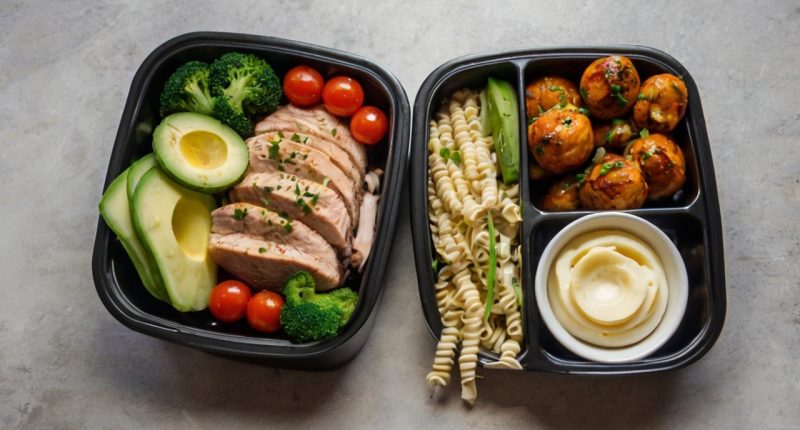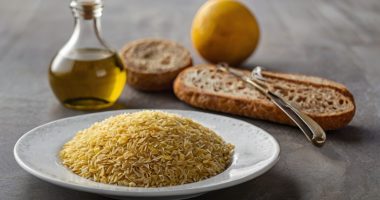Meal prepping is a simple and efficient way to stay on track with healthy eating while saving time and money. By preparing meals in advance, you can avoid the stress of daily cooking and have nutritious options ready whenever you need them. For beginners, it’s important to start with the right tools—like good containers, a sharp knife, and quality cookware—and gradually build your skills with easy-to-follow recipes.
Batch cooking is another key technique that makes meal prep beginners more effective. Cooking larger portions at once allows you to portion out meals for the week, reducing time spent in the kitchen. This approach not only simplifies meal planning but also helps you manage portion sizes, maintain a balanced diet, and minimize food waste. With a few basic strategies, meal prep can become an easy part of your weekly routine.
Table of Contents
Benefits of Meal Prep Beginners
Meal prepping offers numerous advantages that can significantly improve your eating habits, save you time, and enhance your overall health. Here are some key benefits:
- Saves Time: By dedicating a few hours each week to prepare your meals in advance, you can eliminate the daily cooking time, allowing you to focus on other important tasks.
- Cost-Effective: Buying ingredients in bulk and preparing meals at home reduces the temptation to eat out, thus saving money in the long run.
- Portion Control: Meal prep allows you to control portion sizes, helping to prevent overeating and making it easier to stick to dietary goals.
- Healthier Choices: When you prepare your meals, you have full control over the ingredients you use, making it easier to choose nutritious options and avoid processed foods.
- Reduces Food Waste: Planning meals can help you use perishable items before they spoil, minimizing waste and benefiting your wallet.
- Enhances Variety: Preparing meals in advance encourages you to experiment with different recipes and cuisines, promoting a balanced and diverse diet.
- Helps with Routine: Establishing a meal prep routine can help you develop healthier eating habits while reducing stress related to meal planning and cooking.
Planning Your Meals
Effective meal planning is essential for successful meal prep, especially for beginners. Here are some key steps to help you streamline the process and make the most of your meal prep efforts:
1. Determine Your Schedule
Identify how many meals you need for the week. Consider factors like your work schedule, social events, and family commitments. This helps you allocate time for cooking and ensures you prepare enough meals to last through the week.
2. Choose Recipes Wisely
Select recipes that are simple, nutritious, and use similar ingredients to reduce waste. Aim for a mix of proteins, vegetables, and whole grains. Rotating between different recipes each week can also keep your meals exciting without feeling overwhelming.
3. Make a Shopping List
After selecting your recipes, create a comprehensive shopping list of all the ingredients you will need. Organize the list by sections of the grocery store (produce, dairy, etc.) to make your shopping trip more efficient.
4. Prep Ingredients in Advance
Consider doing some meal prep during the week, such as washing and chopping vegetables or marinating meats. This can save a lot of time during your main meal prep session on the weekend.
5. Use a Meal Planner
Utilize a meal planner template or app to visualize your meals for the week. This helps you keep track of what you plan to eat each day and can be a great motivator as you see your progress throughout the week.
6. Be Flexible
While planning is crucial, it’s also important to remain flexible. Unexpected events can arise, so it’s helpful to have a few quick and easy meal options on hand for those busy nights when you may want to steer away from your plan.

By following these planning steps, you’ll set yourself up for success in your meal prep journey, ensuring that you have healthy, ready-to-eat meals throughout the week. This approach not only saves time and money but also makes it easier to stick to your health goals.
Basic Meal Prep Tools
When embarking on your meal prep journey, having the right tools can make the process smoother and more efficient. Here are some essential kitchen tools to consider for successful meal prepping:
- Meal Prep Containers: Invest in a variety of containers, preferably glass or BPA-free plastic, with tight-fitting lids. Look for different sizes to accommodate meals, snacks, and sides. Make sure they are microwave and dishwasher safe for added convenience.
- Cutting Board: A durable cutting board (preferably non-porous) is essential for chopping vegetables, proteins, and other ingredients. Having separate boards for meats and vegetables can help prevent cross-contamination.
- Knives: A sharp chef’s knife will make it easier to prep ingredients quickly and safely. Consider also having a paring knife for smaller tasks and a serrated knife for bread and softer items.
- Measuring Tools: Accurate measuring cups and spoons are crucial for following recipes properly, ensuring the right proportions of ingredients.
- Food Scale: A food scale can help with portion control and precise measurements, particularly if you’re following strict dietary guidelines.
- Blender or Food Processor: These appliances can save time by helping you make smoothies, sauces, or finely chopping ingredients for your recipes.
- Slow Cooker or Instant Pot: These versatile tools can help you prepare larger meals with minimal hands-on cooking time, making batch cooking a breeze.
- Sharp Peeler and Grater: Having a good-quality peeler and a grater can speed up the prep work for vegetables and cheese.
- Spatulas and Wooden Spoons: Use these utensils for stirring and serving meals, helping you to avoid scratching your pots and pans.
- Pans and Baking Sheets: A set of non-stick pots, pans, and baking sheets will allow you to cook up a variety of dishes efficiently.
Equipping your kitchen with these basic meal prep tools will not only make your cooking experience more enjoyable but will also ensure that you can meal prep effectively and maintain your healthy eating goals.
Simple and Nutritious Recipes
When it comes to meal prepping, simplicity is key. Here are three easy and nutritious recipes that you can prepare in advance. Not only are they delicious, but they also pack in essential nutrients to keep you fueled throughout your week.
1. Quinoa and Black Bean Salad
This vibrant salad is rich in protein and fiber, making it a perfect choice for lunch or a light dinner.
- 1 cup quinoa, rinsed
- 2 cups water
- 1 can black beans, drained and rinsed
- 1 cup cherry tomatoes, halved
- 1 bell pepper, diced
- 1/4 cup red onion, diced
- 1/4 cup fresh cilantro, chopped
- Juice of 1 lime
- Salt and pepper to taste
Cook the quinoa in water according to package instructions. Once cooled, mix with the remaining ingredients. Store in airtight containers in the fridge for up to 5 days.
2. Chicken Stir-Fry
This quick and flavorful stir-fry is packed with vegetables and lean protein, making it a wholesome option.
- 1 lb chicken breast, sliced thin
- 2 cups mixed vegetables (broccoli, bell peppers, carrots, etc.)
- 2 tablespoons soy sauce
- 1 tablespoon olive oil
- 1 teaspoon garlic, minced
- 1 teaspoon ginger, minced
In a large skillet, heat olive oil over medium heat. Add garlic and ginger, cooking for about 30 seconds until fragrant. Add chicken and stir until cooked through. Toss in vegetables and soy sauce, cooking until vegetables are tender but crisp. Divide into portions and store for up to 4 days.
3. Overnight Oats
These make for a convenient and healthy breakfast option that you can customize to your taste.
- 1/2 cup rolled oats
- 1 cup almond milk (or milk of your choice)
- 1 tablespoon chia seeds
- 1 tablespoon honey or maple syrup
- 1/2 cup fruit (bananas, berries, etc.)
In a jar, combine oats, almond milk, chia seeds, and sweetener. Stir well and top with your choice of fruit. Cover and refrigerate overnight, and they will be ready to grab in the morning. They can last up to 3 days in the fridge.
4. Mediterranean Chickpea Salad
This hearty salad is high in fiber and protein, making it perfect for a filling lunch or dinner.
- 1 can chickpeas, drained and rinsed
- 1 cup cucumber, diced
- 1 cup cherry tomatoes, halved
- 1/4 cup red onion, diced
- 1/4 cup Kalamata olives, sliced
- 1/4 cup feta cheese, crumbled
- 2 tablespoons olive oil
- 1 tablespoon red wine vinegar
- Salt and pepper to taste
In a large bowl, combine chickpeas, cucumber, tomatoes, red onion, olives, and feta cheese. Drizzle with olive oil and red wine vinegar, and season with salt and pepper. Mix well and store in an airtight container in the fridge for up to 4 days.
5. Vegetable and Egg Muffins
These savory muffins are great for a grab-and-go breakfast or a quick snack, loaded with veggies and protein.
- 6 large eggs
- 1/2 cup spinach, chopped
- 1/4 cup red bell pepper, diced
- 1/4 cup zucchini, grated
- 1/4 cup cheddar cheese, shredded
- Salt and pepper to taste
Preheat the oven to 350°F (175°C). In a mixing bowl, whisk the eggs, then add spinach, bell pepper, zucchini, and cheese. Season with salt and pepper. Pour the mixture into a greased muffin tin, filling each cup about 3/4 full. Bake for 20-25 minutes, or until the muffins are set. Store in the fridge for up to 4 days.
6. Sweet Potato and Black Bean Burritos
These burritos are perfect for meal prep—they’re packed with fiber, protein, and complex carbs to keep you full and energized.
- 1 large sweet potato, peeled and cubed
- 1 can black beans, drained and rinsed
- 1/2 cup corn kernels (fresh or frozen)
- 1/4 cup cilantro, chopped
- 4 whole wheat tortillas
- 1/2 cup shredded cheese (optional)
- Salt, pepper, and cumin to taste
Steam or boil the sweet potato cubes until tender, then mash lightly with a fork. In a large bowl, mix sweet potato, black beans, corn, and cilantro. Season with salt, pepper, and cumin. Divide the mixture evenly among the tortillas, sprinkle with cheese if desired, and roll into burritos. Wrap each burrito in foil, and store in the fridge for up to 5 days or freeze for longer storage.
Batch Cooking Techniques
Batch cooking is a cornerstone of effective meal prep, allowing you to save time and ensure that you always have healthy, home-cooked meals ready to go. Here are some techniques to optimize your batch cooking sessions:
1. Choose Versatile Ingredients
When selecting ingredients for batch cooking, opt for those that can be used in multiple recipes. For example, roasted vegetables can be added to salads, stirred into grains, or used as a side dish. Staples like quinoa, brown rice, and beans are great bases for various meals.
2. Plan Your Cooking Sessions
Schedule dedicated cooking days where you can prepare multiple meals at once. Designing a menu that utilizes overlapping ingredients simplifies your shopping and cooking processes. Consider making enough for the week, breaking it down into meals or components.
3. Cook Large Batches
Utilize larger pots and pans when cooking grains, soups, or stews. Double or triple recipes wherever possible to maximize your output. This method not only saves time but also energy—cooking once for multiple meals is more efficient than cooking single servings repeatedly.
4. Use Freezer-Friendly Recipes
Not all meals are suitable for freezing, but many are. Soups, stews, and casseroles tend to freeze well, allowing you to enjoy them later without sacrificing flavor or texture. Ensure that you cool foods before freezing to preserve their quality.
5. Label and Organize
Proper labeling helps maintain organization in your freezer. Always indicate the contents and date on each container, so you can quickly find meals and avoid freezer burn. Stack containers neatly and group similar items together for easy access.
6. Optimize Cooking Times
While you’re batch cooking, utilize your oven and stovetop simultaneously. For instance, roast vegetables in the oven while quinoa cooks on the stovetop. This multitasking approach can significantly cut down your overall cooking time.
7. Incorporate Make-Ahead Sauces
Creating and storing sauces in advance can enhance the flavor of your meals without much extra effort. Prepare batches of dressings, marinades, or sauces and store them in jars for quick access during the week.
By incorporating these batch cooking techniques, you’ll not only streamline your meal prep process but also ensure you have a repertoire of healthy, convenient meals ready to enjoy throughout the week.
Storing and Reheating Meals
Proper storage and reheating techniques are essential for maintaining the quality and safety of your meal preps. Here are some key points to consider:
Storing Your Meals
1. Use Airtight Containers: Invest in quality airtight containers to keep your meals fresh. Glass containers are ideal as they do not retain odors and are microwave-safe.
2. Label and Date: Always label your containers with the contents and date they were prepared. This helps ensure you consume meals while they’re still fresh.
3. Cool Down Before Storing: Allow cooked meals to cool down to room temperature before sealing and refrigerating them. This helps prevent condensation and spoilage.
4. Follow FIFO Principle: Use the First In, First Out principle. Consume older meals first to minimize waste and ensure that you’re eating fresh food.
Reheating Techniques
1. Microwave: This is the quickest method. Use a microwave-safe container and cover your meal with a microwave-safe lid or wrap to retain moisture.
2. Oven: For dishes that can get soggy in the microwave, reheating in the oven is a great option. Preheat your oven to about 350°F (175°C) and heat until warmed through.
3. Stovetop: Reheating on the stovetop can work well for soups, stews, and stir-fries. Add a splash of water or broth to prevent burning and maintain texture.
4. Check Temperature: Always ensure food is heated to an internal temperature of 165°F (74°C) before consuming to avoid any foodborne illnesses.
By following these storing and reheating guidelines, you can enjoy your meal preps while maximizing freshness and flavor.
Frequently Asked Questions
What is meal prep?
Meal prep is the process of preparing meals in advance to save time during the week, promote healthy eating, and reduce food waste.
Why is meal prepping beneficial for beginners?
Meal prepping helps beginners manage their time better, stick to healthier eating habits, and avoid last-minute unhealthy food choices.
What are some easy recipes to start meal prepping?
Some easy meal prep recipes include grilled chicken with roasted vegetables, quinoa salad, overnight oats, and stir-fried tofu with rice.
How can I organize my meal prep for the week?
You can organize your meal prep by planning your meals for the week, creating a shopping list, and dedicating a specific day for cooking and portioning out your meals.
What containers should I use for meal prepping?
Using clear, BPA-free containers with airtight seals is ideal for meal prepping as they help keep food fresh and allow you to see what’s inside.
Can I freeze meal prep meals?
Yes, many meal prep meals can be frozen. Make sure to use appropriate freezer-safe containers and label them with the date and contents.
How can I make meal prep more enjoyable?
To make meal prep more enjoyable, you can listen to music or podcasts while cooking, involve family or friends, and experiment with new recipes and ingredients.





